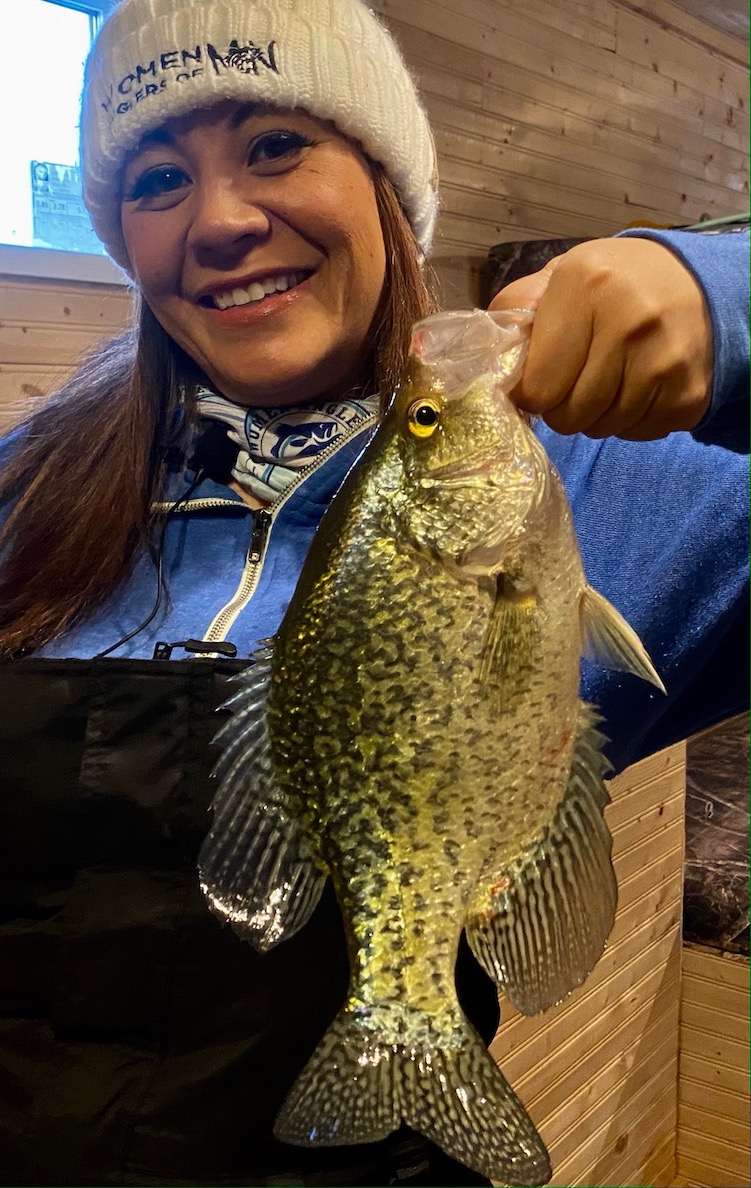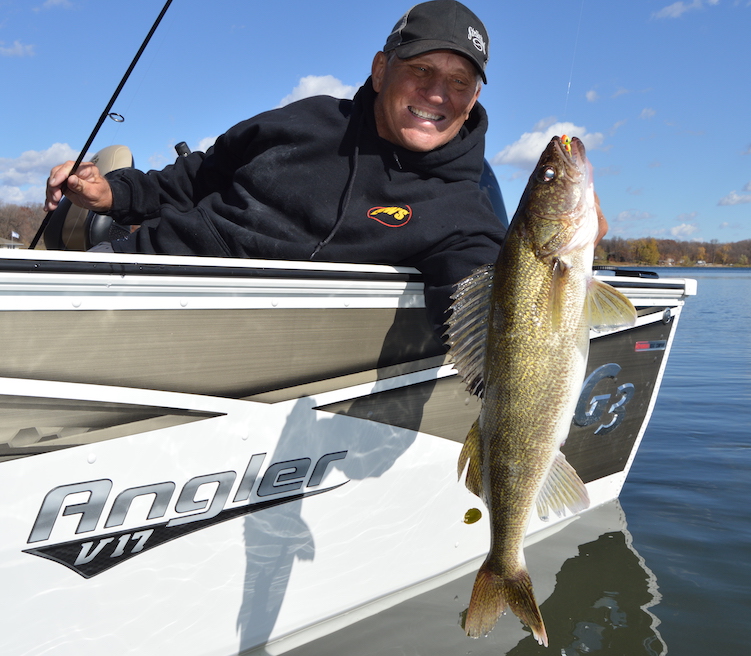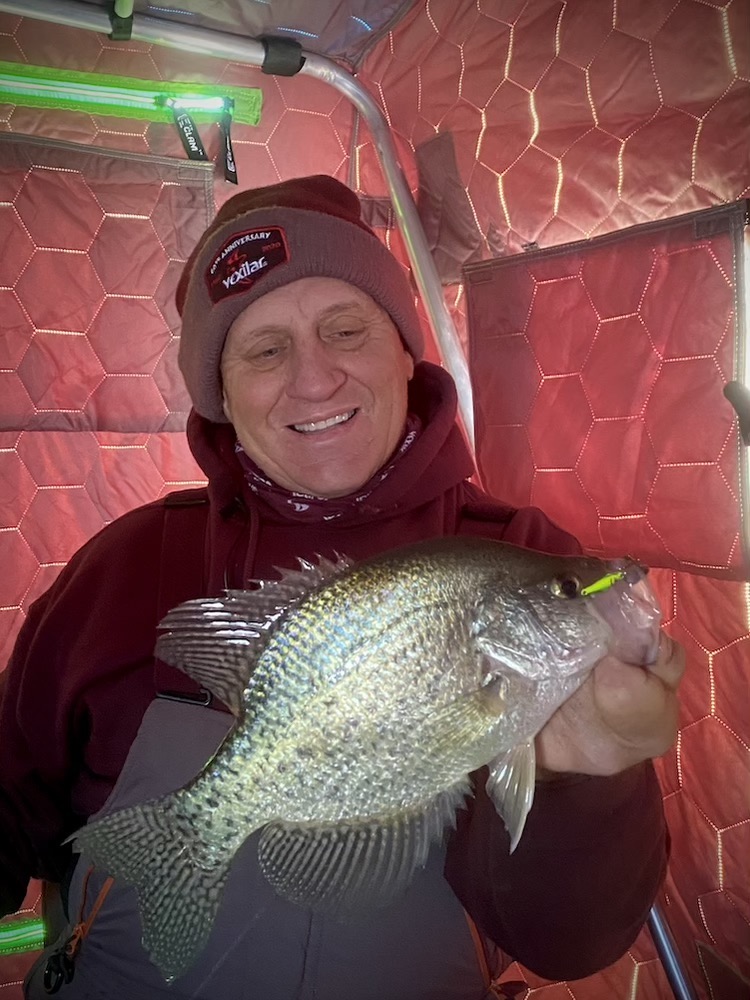News & Stories
Late Ice is Panfish Time!
Posted by director on February 22, 2021

Late Ice Panfish
There’s still time!
By Mike Frisch
As we enter the last few weeks of winter, some anglers have already stowed their ice fishing gear and are preparing for open water. That may be a mistake, particularly for those anglers who enjoy catching panfish like crappies and bluegills. Right now, these fish are vacating some of the deep basins they called home during mid-winter and moving back shallow. And, most importantly, they often have one thing on their minds: finding food!
A key to catching late ice panfish is staying on the move searching for active fish. Fortunately, late winter is a great time for searching as the weather is often nice meaning an angler can move around and drill lots of holes looking for fish while enjoying some of the coming spring’s first warm days.
When searching to find late ice panfish, I usually target the mouths of bays that are known to hold feeding and spawning bluegills and crappies later in spring. The fish often start to stage on the drop-off edges leading into these bays during late ice, anticipating spring and open water.
I drill holes on these edges looking for fish and the presence of weeds, especially green weeds showing life. Green weeds along a drop-off adjacent to a shallow bay can be the proverbial “spot on the spot” for late ice panfish.
Crappies and gills in these areas can often be caught in good numbers utilizing a pretty simple fishing set-up. A small tungsten jig fished on light line and tipped with waxworms or a small plastic bait is my “go to” rig at this time.
Tungsten jigs are denser than lead jigs meaning they fish “heavier.” A small profile, yet heavy jig “crashes” through slush in the fishing hole as well as any weeds encountered on the way to the fish. And, because panfish often come through in schools, another advantage of tungsten jigs is that their quick fall rate quickly gets them back down to the remaining fish after one has been caught.
My favorite tungsten jigs are the Drop Jig and Drop Jig XL. These jigs come in several sizes, a variety of good colors, and have “sticky” hooks. The Drop tipped with a couple waxworms has been very productive. However, spring panfish often love small Maki plastics on jigs and that’s where the Drop XL with its bigger hook really shines.
Most days during spring, I’ve been able to catch more fish tipping with plastics. The fish really seem to like the added action of a quivering plastic and several fish can often be caught on the same bait, meaning I spend more time fishing and less time re-baiting!
My rod and reel set-up for fishing small jigs consists of a spring bobber rod and reel loaded with 3-pound line. The ultra-light Scepter Stick spring bobber rod I use does a nice job of letting me know when I get bit, yet has the power needed to pull scrappy panfish from the weeds.
A final essential gear item needed is a good winter sonar unit. The Vexilar flashers I use have great target separation. Target separation when fishing panfish in the weeds is very important because it lets me identify, and target, individual fish in a school from other fish and from the weeds as well.
Experiencing good ice fishing action yet this season is very possible. Heading to a good panfish lake and using some of the tips provided here just might, in fact, help you get in on some of the year’s fastest fishing action right now!
And, as always, remember to include a youngster in your next outdoors adventure.
Mike Frisch hosts the popular Fishing the Midwest TV series. Visit www.fishingthemidwest.com to see all things Fishing the Midwest.
Photo – Stephanie Lawson of the Women Anglers of Minnesota with a big crappie she caught in February. Crappies and bluegills move shallow in March and provide great fishing opportunities at “last ice!”
Open Water Dreaming, 2021 Style!
Posted by director on February 11, 2021

Looking forward to open water!
By Mike Frisch
Now is the time of year when I really start to get anxious for open water. I’ve had lots of fun on the ice, but a few warm mid-winter days have me thinking about, and looking forward to, open water again. Here are three of my favorite bites, one from each open water season, that I hope to capitalize on this coming season.
Casting the shallow rocks during spring – Big Stone Lake
Big Stone Lake, on the Minnesota/South Dakota border, no longer has a “closed season” for gamefish like walleyes, northern pike, and bass. For that reason, I am hoping for an early April ice out, which means I can make the short trip west from my home several times to get a jump on the traditional inland Minnesota walleye season that opens on May 15 this year.
Big Stone’s early season walleyes are often pre-spawn and hungrily roaming the lake’s rocky shorelines looking for baitfish. The bite often starts “up north” and moves south as the water warms and some of the fish migrate down the lake. And, the somewhat steeper rocky shorelines on the South Dakota side seem to attract hungry fish as they use the shoreline’s “rock wall” to trap baitfish along.
A simple jig and minnow combination worked slowly along the rocks is often productive. However, some of the bigger fish I caught last spring from Big Stone came on a jig and Rage Swimmer swimbait combination cast and retrieved back to the boat.
Regardless the lure chosen, it is often sound advice to stay on the move looking for active fish when targeting Big Stone’s spring walleyes.
To learn more about the Big Stone area, visit www.bigstonelake.com
Casting the summer weedlines – Alexandria Lakes Area
July and August can be challenging times for walleye and panfish anglers as the good shallow bites of early season for these species have passed. The heat of summer, however, is often prime time for largemouth bass fishing, particularly those roaming lush deep weedlines. And, Midwest anglers would be hard pressed to find an area with more lakes with better deep weedlines, and with more bass than the Alexandria, MN area has!
The famed “Alex Chain” is a prime example, but there are a variety of other lakes, both big and small, in the area that host excellent largemouth bass populations as well.
A simple way to fish these lakes is to hold the boat just out from the deep weedline and cast mid- to deep-diving crankbaits ahead and along the weedlines and reeling them back to the boat. The Pro Model crankbaits come in a variety of sizes for effectively targeting weedlines in various water depths. Plus, these baits come in baitfish-imitating patterns like bluegill, sunfish, and perch patterns that mimic the baitfish that Alexandria area bass feed on.
More regarding the Alexandria lakes area can be learned by visiting www.ExploreAlex.com
Casting the rock reefs during fall – Kabetogama Lake
I have fished Kabetogama Lake in Voyageurs National Park one time during fall for smallmouth bass. And, that is a mistake!
The mistake being that I haven’t found time to go back, as the very biggest smallmouth bass of my life (in the 6 pound range) came in the boat on my very first cast of that trip! I was fishing with Tim Snyder who guides on KAB and Fishing the Midwest TV founder Bob Jensen. The three of us caught a bunch of other smallmouth in the 3 to 6 pound category in just a few hours that day.
We targeted rock reefs in deep basins that the smallmouth bass were roaming on, feeding aggressively in preparation for winter. Tim and Bob cast jig/minnow combinations, while I used finesse plastics fished on drop-shots rigs. I don’t think bait choice mattered much though, as these fish were flat out aggressive!
Plus, that evening and the next day, Tim put us on an excellent bite for big walleyes too.
For more information regarding KAB, visit www.kabetogama.com.
* * *
As always, good luck on the water this season and remember to include a youngster in your next outdoors adventure!
Mike Frisch hosts the popular Fishing the Midwest TV series. Visit www.fishingthemidwest.com to see all things Fishing the Midwest.
Photo – Mike Frisch hopes big walleyes like this are part of his angling adventures in 2021.
Tough Time But A Good Crappie Bite!
Posted by admin on January 26, 2021

By Mike Frisch
February can be a difficult time for this outdoorsman and I’m suspecting other outdoors lovers too. The good early ice bite has passed, hunting seasons are closed, and the open-water of spring is still a ways off. Luckily, a dependable deep-water, basin crappie fishing pattern sets up on many Midwestern lakes now. Here is a look at some keys to capitalizing on this bite right now.
Where
Relatively featureless basins within the main lake body or within larger bays will often hold roaming crappies during mid- to late-winter. In several of the shallower lakes that I fish, these basins may be in 20 to 30 feet of water. In deep-water lakes, however, these basins may be deeper.
Regardless the basin depth in a lake, staying on the move is important to consistent success as these fish will often roam about looking for food. And, even once found, basin fish are often on the move so the most successful anglers stay mobile, drilling holes to stay with moving fish.
Good electronics and a lightweight, dependable ice auger are important to a mobile approach. The K-Drill I use is lightweight, cuts quickly, and is powered by a 9-volt battery, so if the battery is charged, it will start!
When
Water clarity seems to be a factor in when these fish feed most actively. If a lake has “off-colored” water, the bite may be good during the day. In clear water lakes, however, a late afternoon on into the evening bite often prevails.
My best successes when fishing this pattern come when fishing from a portable shelter that allows me to stay as mobile as possible. Because this bite can be good in the evening, some anglers prefer to put a “permanent” fish house on a productive spot and wait for roaming schools to pass through during the peak late afternoon/early evening time frame.
On some waters, this bite will last for several hours into later evening as well, making this a fun way to pass a mid-winter evening!
How
My most productive winter panfish lures are usually small jigging spoons or tungsten jigs. The spoons are often tipped with small minnow heads, while tungsten jigs pair well with waxworms. Though, during this time frame, plastics seem to produce more fish most days.
A 1/16-ounce Pinhead Jigging Mino in a glow color pattern and small minnow head combination is often a good starting lure. This bait will pick off the active fish from a school and often appeals to some of the bigger “slabs.”
Some days on some waters, however, a quivering plastic bait on small tungsten offering will trigger the most bites and, sometimes, by a wide margin. A 1/16-ounce Drop Jig XL tipped with a small Maki plastic offers undulating action that attracts and triggers crappies into biting. A variety of colors will work, though I prefer jigs in glow red, pink, and white tipped with a white glow plastic.
I often use a fairly aggressive jigging presentation in an attempt to “call in” fish near the bait. Once there, slowing up and just quivering the bait is often too tempting for even the most finicky crappie to refuse!
A final bit of advice is to use a quality flasher with good target separation. The new FLX-30 I use allows me to easily see my bait, any fish that come near it, and “separates” the bait from individual fish when several crappies suspend in the water column near my bait. This allows me to target individual fish and maximize my catch!
February can be a challenging time for those who like the outdoors. If maximizing your time outside this month is a goal, consider giving basin crappies a try. Using some of the tips just provided can, in fact, get you in on a good crappie bite and increase your winter enjoyment right now!
As always, good luck on the ice and remember to include a youngster in your next outdoors adventure!
Mike Frisch hosts the popular Fishing the Midwest TV series. Visit www.fishingthemidwest.com to see all things Fishing the Midwest.
Photo – The author with a mid-winter basin crappie caught using the tips presented here.
